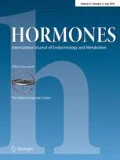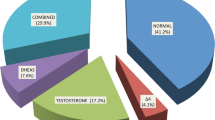Abstract
OBJECTIVE
To evaluate the impact of elevated serum Δ4A levels on the hormonal and metabolic features of the different phenotypes of PCOS.
DESIGN
1276 women with PCOS according to the Rotterdam criteria were included, in whom serum hormonal levels were determined.
RESULTS
In PCOS women as a whole, as well as in patients presenting clinical and/or biochemical hyperandrogenemia (phenotypes I and II), Δ4A levels >3.8 ng/ml were positively related to LH, LH/FSH ratio, T, DHEAS, 17 OH progesterone and FAI and negatively related to T/Δ4A ratio. In the milder phenotype III, a positive correlation between Δ4A levels >3.8 ng/ml and T, DHEAS, 17 OH progesterone and FAI and a negative one between increased Δ4A and T/Δ4A ratio were reported. In the whole PCOS group with androstenedione >3.8 ng/ml, an increased ovarian volume was observed, while a greater mean follicular number was found only in phenotypes I and II.
CONCLUSIONS
Increased serum Δ4A levels, which are associated with more severe PCOS phenotypes, possibly contribute to the worsening of PCOS features and therefore could be a valuable marker of biochemical hyperandrogenemia.
Similar content being viewed by others
References
Azziz R, Woods KS, Reyna R, et al, 2004 The prevalence and features of the polycystic ovarian syndrome in an unselected population. J Clin Endocrinol Metab 98: 2745–2749.
The Rotterdam ESHRE/ASRM-Sponsored PCOS Consensus Workshop Group, 2004 Revised 2003 consensus on the diagnostic criteria and long term health risks related to polycystic ovary syndrome. Fertil Steril 81: 19–25.
Azziz R, 2006 Controversy in clinical endocrinology: Diagnosis of polycystic ovarian syndrome: The Rotterdam criteria are premature. J Clin Endocrinol Metab 91: 781–785.
Welt CK, Gudmundsson JA, Arason G, et al, 2006 Characterizing different subsets of polycystic ovary syndrome as defined by the Rotterdam criteria: The impact of weight on phenotype and metabolic features. J Clin Endocrinol Metab 91: 4842–4848.
Azziz R, Sanchez LA, Knochenhauer ES, et al, 2004 Androgen excess in women: experience with over 1000 consecutive patients. J Clin Endocrinol Metab 89: 453–462.
Pasquali R, Gambineri A, Cavazza C, et al, 2011 Heterogeneity in the responsiveness to long-term lifestyle intervention and predictability in obese women with polycystic ovary syndrome. Eur J Endocrinol 164: 53–60.
Doi SA, 2008 Neuroendocrine dysfunction in PCOS: a critique of recent reviews. Clin Med Res 6: 47–53.
Ferriman D, Gallwey JD, 1961 Clinical assessment of body hair growth in women. J Clin Endocrinol Metab 21: 1440–1447.
Vermeulen A, Verdonck L, Kaufman JM, 1999 A critical evaluation of simple methods for the estimation of free testosterone in serum. J Clin Endocrinol Metab 84: 3666–3672.
Carmina E, Lobo RA, 2004 Use of fasting blood to assess the prevalence of insulin resistance in women with polycystic ovary syndrome. Fertil Steril 82: 661–665.
Gilling-Smith C, Willis DS, Beard RW, Franks S, 1994 Hypersecretion of androstenedione by isolated thecal cells from polycystic ovaries. J Clin Endocrinol Metab 79: 1158–1165.
Knochenhauer ES, Key TJ, Kahsar-Miller M, Waggoner W, Boots LR, Azziz R, 1998 Prevalence of the polycystic ovary syndrome in unselected black and white women of the southeastern United States: a prospective study. J Clin Endocrinol Metab 83: 3078–3082.
Azziz R, Carmina E, Dewailly D, et al, 2009 Task Force on the Phenotype of the Polycystic Ovary Syndrome of The Androgen Excess and PCOS Society. The Androgen Excess and PCOS Society criteria for the polycystic ovary syndrome: the complete task force report. Fertil Steril 91: 456–488.
Yilmaz M, Isaoglu U, Delibas IB, Kadanali S, 2011 Anthropometric, clinical and laboratory comparison of four phenotypes of polycystic ovary syndrome based on Rotterdam criteria. J Obstet Gynaecol Res 37: 1020–1026.
Azziz R, Black V, Hines GA, Fox LM, Boots LR, 1998 Adrenal androgen excess in the polycystic ovary syndrome: sensitivity and responsivity of the hypotha-lamic-pituitary-adrenal axis. J Clin Endocrinol Metab 83: 2317–2323.
Pasquali R, Patton L, Pocognoli P, Cognigni GE, Gambineri A, 2007 17-hydroxyprogesterone responses to gonadotropin-releasing hormone disclose distinct phenotypes of functional ovarian hyperandrogenism and polycystic ovary syndrome. J Clin Endocrinol Metab 92: 4208–4217.
Akhtar MK, Kelly SL, Kaderbhai MA, 2005 Cytochrome b(5) modulation of 17{alpha} hydroxylase and 17–20 lyase (CYP17) activities in steroidogenesis. J Endocrinol 187: 267–274.
Hall JE, Taylor AE, Hayes FJ, Crowley WF Jr, 1998 Insights into hypothalamic pituitary dysfunction in polycystic ovary syndrome. J Endocrinol Invest 21: 602–611.
Ehrmann DA, 2005 Polycystic ovary syndrome. N Engl J Med 352: 1223–1236.
Barontini M, García-Rudaz MC, Veldhuis JD, 2001 Mechanisms of hypothalamic-pituitary-gonadal disruption in polycystic ovarian syndrome. Arch Med Res 32: 544–552.
Greisen S, Ledet T, Ovesen P, 2001 Effects of androstenedione, insulin and luteinizing hormone on steroidogenesis in human granulosa luteal cells. Hum Reprod 16: 2061–2065.
Okutsu Y, Itoh MT, Takahashi N, Ishizuka B, 2010 Exogenous androstenedione induces formation of follicular cysts and premature luteinization of granulosa cells in the ovary. Fertil Steril 93: 927–935.
Jakimiuk AJ, Weitsman SR, Magoffin DA, 1999 5alpha-reductase activity in women with polycystic ovary syndrome. J Clin Endocrinol Metab 84: 2414–2418.
Agarwal SK, Judd HL, Magoffin DA, 1996 A mechanism for the suppression of estrogen production in polycystic ovary syndrome. J Clin Endocrinol Metab 81: 3686–3691.
Ehrmann DA, Barnes BB, Rosenfield RL, 1995 Polycystic ovary syndrome as a form of functional ovarian hyperandrogenism due to dysregulation of androgen secretion. Endocr Rev 16: 322–353.
Marioli DJ, Saltamavros AD, Vervita V, et al, 2009 Association of the 17-hydroxysteroid dehydrogenase type 5 gene polymorphism (-71A/G HSD17B5 SNP) with hyperandrogenemia in polycystic ovary syndrome (PCOS). Fertil Steril 92: 648–652.
Misichronis G, Georgopoulos NA, Marioli DJ, et al, 2012 The influence of obesity on androstenedione to testosterone ratio in women with polycystic ovary syndrome (PCOS) and hyperandrogenemia. Gynecol Endocrinol 28: 249–252.
Author information
Authors and Affiliations
Corresponding author
Rights and permissions
About this article
Cite this article
Georgopoulos, N.A., Papadakis, E., Armeni, A.K. et al. Elevated serum androstenedione is associated with a more severe phenotype in women with polycystic ovary syndrome (PCOS). Hormones 13, 213–221 (2014). https://doi.org/10.1007/BF03401335
Received:
Accepted:
Published:
Issue Date:
DOI: https://doi.org/10.1007/BF03401335




